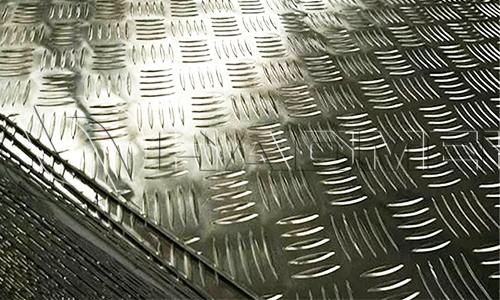Checker plates aluminium 2.8mm
June 1, 2021
Checker plates aluminium 2.8mm are usually five bar or diamond aluminum sheets of 2.8mm thick. Five bar and diamond serve as two of the most popular patterns for aluminum checkered plates. Other patterns include three bars, four bars, leaf etc. In any case the bars or design are arranged like lined groups of checkers. On a five bar sheet five convex ribs parallel each other to form a beautiful diamond-shaped unit. The sheet surface is covered with such regular units to achieve an excellent anti-skid effect. With development in people’s pursuit of aesthetic diversity, aluminum plates of other patterns have been developed. They are named vividly according to the shape of the patterns.

A 2.8mm aluminum tread plate cover many alloys, including 1060, 1100, 3003, 5052, 5083, 5754, 6061 and 6082. The alloys are combined with various patterns and surface treatment methods to create varied products demanded in various fields. Each group of the plates have its own advantages and disadvantages. 1060 and 1100 aluminium checker plates are featured by low hardness, good corrosion resistance and cheap price. 3003 are better in hardness and anti-rust performance, but higher in price. 5052, 5083 and 5754 are stronger than 3003 in strength and resistance to rust, and even higher in price. 6061 and 6082 are the strongest and most expensive, but poorer in corrosion resistance than 5000 alloys. Therefore, the price of checker plates aluminium 2.8mm is really up to the specification you need. In addition to alloys, size and length influence the price of 2.8mm aluminium checker plates as well. Regular width ranges from 100mm to 1850mm, and length 500mm to 16000mm. If you need plates of a size out of the range, you will have to pay cost for extra production fees.
2.8mm is a relatively big thickness for aluminium checker plate, though the thickest plates reach 8mm thick. Alu checker plates over 3mm are rarely applied, except in some applications with weight bearing requirements. 2.8mm aluminum checker plates are applied to anti-skid, cladding and walling purposes in transport stations, entertainment spaces, gyms and various vehicles. In particular, they serve as a main wall material for tool boxes of trucks, dual cab canopies, vans etc.


 Nydia
Nydia
 Sales Manager
Sales Manager